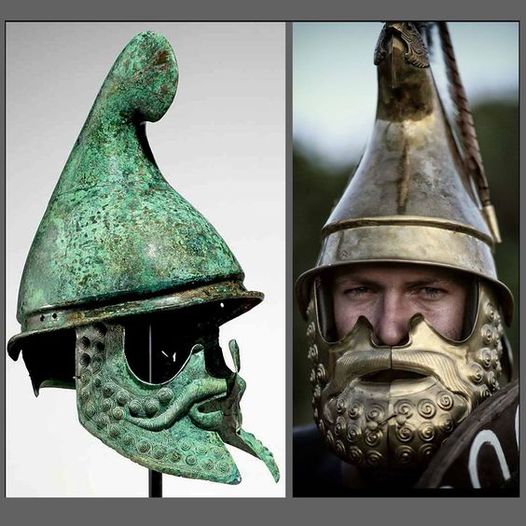The Phrygian helmet is a remarkable and iconic artifact of ancient military history, capturing the intrigue of historians, archaeologists, and military enthusiasts. Originating in Classical Greece, this distinctive helmet design eventually saw widespread use across the ancient Mediterranean world, from Thrace and Dacia to Magna Graecia and the Hellenistic kingdoms. Its unique design and symbolic significance make it a fascinating subject for exploration.
Believed to have emerged during the 5th century BC in Classical Greece, the Phrygian helmet is also known as the Thracian helmet. The name “Phrygian” derives from its resemblance to the traditional caps or hoods worn by the Phrygian people, an ancient Indo-European civilization based in what is now central Turkey. Its defining features include a high, forward-inclined apex and characteristic cheek pieces that extended down to protect the wearer’s face. This innovative design provided ancient warriors with superior protection while maintaining visibility and mobility on the battlefield, addressing the practical needs of combatants in a time of constant warfare.

The helmet’s introduction coincided with the flourishing of Greek city-states and their conflicts, which demanded advancements in military technology. Initially associated with the Phrygians and Thracians, the helmet’s practicality and distinctiveness led to its adoption by various ancient civilizations. The design not only enhanced the safety of warriors but also became a symbol of martial prowess and cultural identity.
The Phrygian helmet quickly gained prominence across the Mediterranean, finding favor among diverse civilizations, including the Thracians, Dacians, and the peoples of Magna Graecia, the Greek colonies in southern Italy. Its use in ancient warfare became especially prominent during the reign of King Philip II of Macedon, the father of Alexander the Great. Under Philip II, the Macedonian cavalry utilized the Phrygian helmet to great effect, demonstrating its functionality in combat.
While Alexander the Great is often associated with the open-faced Boeotian helmet for his cavalry, the Phrygian helmet remained a staple for the infantry forces of his legendary army. This is evidenced by its depiction on the Alexander Sarcophagus, a masterpiece of Hellenistic funerary art that showcases the military might of Alexander’s forces. The enduring presence of the Phrygian helmet in various armies attests to its practicality and widespread appeal, transcending its cultural origins.
Beyond its functional role in battle, the Phrygian helmet held profound symbolic significance. Its distinctive forward-inclined apex became a visual marker of the “barbarian warrior” in ancient iconography, evoking the fierce and skilled fighters from the northern Mediterranean regions. The helmet’s unique shape and cultural associations made it a powerful emblem of identity for the Phrygian and Thracian peoples. Greek and Roman art frequently depicted foreign warriors wearing Phrygian helmets, reinforcing its status as a symbol of the exotic and formidable.
The symbolic importance of the helmet extended beyond the battlefield. In art and sculpture, the Phrygian helmet served as a shorthand for strength, courage, and the untamed spirit of the ancient warriors who wore it. Its use in these contexts highlights how deeply it resonated within the cultural consciousness of the ancient world.
The helmet’s enduring legacy is further evidenced by its inclusion in countless artistic representations throughout history. From classical sculptures to modern-day historical fiction and fantasy, the Phrygian helmet has become a symbol of ancient warfare, evoking the valor and ingenuity of the civilizations that employed it. Its continued presence in cultural depictions demonstrates the timeless fascination with this remarkable artifact.
Archaeological discoveries have further enriched our understanding of the Phrygian helmet. For instance, the discovery of an exceptionally well-preserved iron helmet in the royal burial at Vergina offers invaluable insights into its construction, materials, and use. Such findings underscore the advanced craftsmanship and technological achievements of the ancient artisans who created these military artifacts.
The Phrygian helmet’s design reflects the interplay between cultural influences and military strategies in the ancient Mediterranean. Its adoption by various civilizations highlights the interconnectedness of the ancient world, where ideas, technologies, and artistic styles were exchanged and adapted across regions. This interconnectedness is a testament to the dynamic and evolving nature of ancient societies, where innovations like the Phrygian helmet could transcend their origins to become a shared legacy.
In the broader context of ancient military history, the Phrygian helmet stands as a testament to the ingenuity and adaptability of ancient warriors and their societies. Its enduring appeal lies not only in its practical applications but also in its rich cultural and symbolic resonance. The helmet embodies the spirit of a time when warfare was both a practical necessity and a profound cultural expression.
Even in the modern era, the Phrygian helmet continues to captivate scholars, enthusiasts, and the public alike. Its distinctive design serves as a reminder of the creativity and resourcefulness of ancient civilizations, offering a tangible connection to the past. The helmet’s legacy is preserved in museums, artistic representations, and historical studies, ensuring that its story remains a vital part of our understanding of ancient history.
The enduring significance of the Phrygian helmet lies in its ability to bridge the gap between the practical and the symbolic, the historical and the artistic. By studying artifacts like the Phrygian helmet, we gain a deeper appreciation for the complexities of ancient societies and their enduring impact on the modern world. Each discovery and analysis adds to our collective knowledge, enriching our understanding of the ancient Mediterranean’s rich tapestry of cultures and histories.
As we continue to uncover and explore the artifacts of the ancient world, the Phrygian helmet serves as a powerful reminder of the ingenuity and artistry of those who came before us. Its legacy endures, inspiring admiration and curiosity for generations to come. Through its study, we not only learn about the past but also gain insights into the shared human experiences that connect us across time and space.





